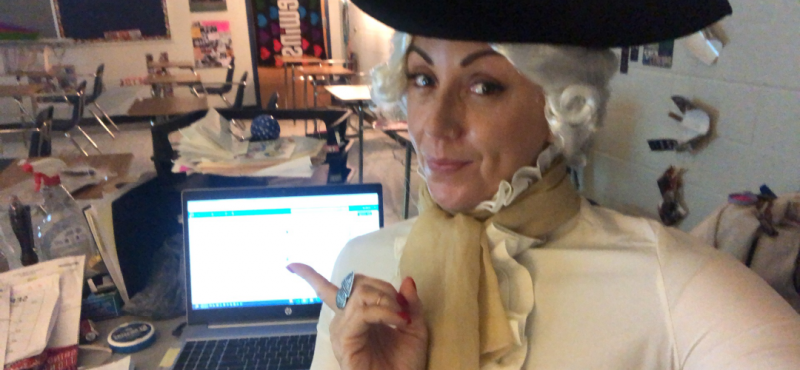Meaghan, a high school teacher in Virginia, goes to great lengths to keep her history students engaged.
As many schools now move onto their second month of a new school year, students and teachers across the country are adjusting to the realities of virtual learning. According to a recent study, 52% of American students are attending fully online classes this fall, while another 19% are doing some form of hybrid learning. But while much has been written about the effects on children and families, not as much attention has been paid to teachers, who have converted their homes into impromptu studios in order to broadcast the lessons that appear on our screens. We spoke to teachers across the country to ask what they’d like parents to know about their experiences during the pandemic. Their answers might surprise you!
1. Broadband Is Key
“My son works on the second floor, my daughter and I work on the first floor, and my husband set up his home office in our basement,” says Jodi, an instructional coach and literacy coordinator in Easthampton, MA. With all floors of the household connected simultaneously to the internet, a strong internet connection became a family priority. Over the summer we purchased a high-speed option, and we now have a gig of bandwidth,” she says. The family, which has three people on Zoom at any given time, has seen significant improvement in their connectivity.
2. Everyone Is Emergent
A number of teachers emphasized the fact that, in addition to their standard lesson planning, they have had to take a crash course in online pedagogy and teaching technology. “Most everything that I am doing I learned through trainings right before the school year started,” says Avery, a fourth-grade teacher in North Carolina. “I have been doing a lot of learning on the fly so I can give the best instruction to my students.”
As Jodi points out, this means teachers are working around the clock in order to learn how to teach remotely. “No matter what your experience and tenure, teachers are all emergent this year,” she says. “We have been tasked with turning a paper-and-pencil curriculum into digital slide decks, Jamboards, and shared documents. It’s a brave new world for us.”
3. Be Supportive
“I’ve had parents declare that they wouldn’t be able to learn online,” says Sarah, a fourth-grade teacher in Virginia. “This educational situation isn’t ideal by any means, but kids can, and will, learn if they utilize this opportunity. It is so important that parents use supportive words about what everyone is doing – it will go a long way.” And for those parents worried about their children falling behind, she offers some necessary perspective. “Fall behind who? Everyone is in the same situation. Make the best of it.”
In Avery’s words, it’s a question of giving online learning a chance. “If you are going into this with a mindset of ‘this is the worst idea ever, we just need to get these kids back into the school,’ you are setting the tone for not only how you are looking at the school year, but how your child is looking at it, as well.”
4. Teachers Have Lives, Too
“Sometimes there are circumstances where we have something going on around us that we need to take care of, just like any other adult,” Avery points out. “Many teachers have kids of their own that are getting put on the back burner because the teacher is focusing on the students on the screen; some teachers have even gotten in trouble for taking care of their families during school hours. Parents shouldn’t forget that we are people too.”
As Meaghan, a high school teacher in Virginia, puts it succinctly: “We’re not sitting at home, relaxing and watching TV in our PJs, but rather rewriting all of our lesson plans so as to best accommodate our students.”
5. Safety Saves Lives
When it’s time to return to the classroom, says Amanda, a pre-K and kindergarten teacher in Ohio, it’s important that parents embrace mask-wearing and other necessary safety measures. “Children are highly capable and very able to wear masks properly and safely in the classroom,” she says. “In my classroom all children wear masks and have a positive view on masking. I think it’s important to tell children the ‘why’ behind wearing them. It’s a great introduction for them on ways we can care for others.”
While teachers work valiantly to adapt their lessons to a virtual environment, the importance of the internet in providing a safe space for learning has become crystal clear. That is why, across the country, internet service providers are teaming up with school districts to make sure that all students are connected – in school and at home. To find out about how a Texas college teamed up with Comcast to make broadband a reality for its students, click here.
